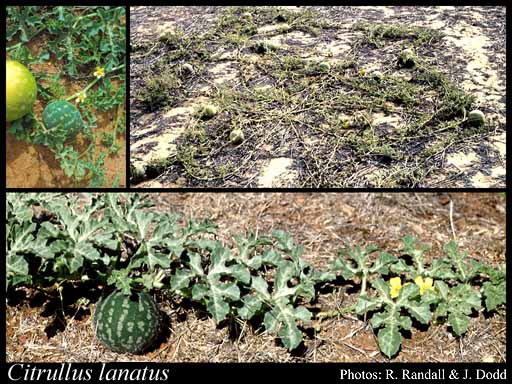This name is not current. Find out more information on related names.
- Reference
- Cat.Sem.Spor. 30 (1916)
- Conservation Code
- Not threatened
- Naturalised Status
- Alien to Western Australia
- Name Status
- Not Current
Trailing annual, herb or climber. Fl. yellow, Jan to Dec. Sandy gravelly soil, loam, clay. Plains, river banks, centres of dry lakes, drainage areas, disturbed areas.

Management Notes (for the Swan NRM Region)
Alternative Names. Citrullus amarus.
General Biology. Growth form. Herb. Life form. Perennial. Reproduction. Seed germination.. Dispersal. Seed dispersal by wind, water and animals.. Seedbank persistence. 2 to 4 years. Keep out moisture and humidity, store in cool, dark and dry place.. Fire response. Seeder (>70% mortality when subject to 100% leaf scorch)..
Notes. The stems are several metres long, covered with long soft hairs, woolly towards the tip, armed with once- or twice-branched tendrils. The leaves are alternate, to 20 cm long, 15 cm wide, ovate to heart-shaped, deeply lobed into 2 or 4 opposite lobes and 1 terminal lobe, each again lobed or toothed, upper surface glabrous or slightly hairy, lower surface shortly hairy and rough; stalk hairy and equal to or longer than the leaf blade. The flowers are yellow, 1 to 1.5 cm long, 3 to 4 cm diameter; petals 5, united near the base, hairy or woolly; borne singly on short hairy stalks in leaf axils; male and female flowers on the same plant. The fruit is green mottled with white and light green; smooth, glabrous, spherical or ellipsoid, to 15 cm diameter, containing numerous seeds embedded in a solid white flesh. The seed is brown with black stripes when mature, slightly roughened, broadly oval, flattened, about 1 cm long. The root is stout taproot with numerous laterals..
Additional information. Origin. A native of tropical and southern Africa.. History of use/introduction. It was known on Kangaroo Island, South Australia in 1836, and was being offered for sale by a Tasmanian nursery in 1845. It was introduced by either intentionally as camel food or unintentionally as a contaminant..
Suggested method of management and control. Cultivation of seedlings is effective, but often inappropriate on the types of country infested. It must be repeated each time seedlings emerge and may increase erosion problems in semi-arid areas. Cultivation is less effective as plants mature because the taproot may not be dislodged and destroyed. Grubbing of isolated plants, removing most of the taproot, is effective but restricted to sparse infestations. In any programme, if fruit are formed, theyThe cost of herbicides is often not justified on marginal country, but triclopyr and metsulfuron methyl are known to be effective on young plants; older plants becoming resistant. The addition of a spray oil improves the level of control with triclopyr. Read the manufacturers' labels and material safety data sheets before using herbicides. For further information consult the Australian Pesticides and Veterinary Medicines Authority to determine the status of permits for your situation or state.
Management Calendar
| Calendar Type | Jan | Feb | Mar | Apr | May | Jun | Jul | Aug | Sep | Oct | Nov | Dec | Comments |
|---|---|---|---|---|---|---|---|---|---|---|---|---|---|
| Germination | Y | Y | Y | Y | Y | Y | |||||||
| Flowering | Y | Y | Y | Y | Y | ||||||||
| Fruiting | Y | Y | Y | O | |||||||||
| Dormant | O | Y | O |
Legend: Y = Yes, regularly, O = Occasionally, U = Uncertain, referred by others but not confirmed.
References
- Latz, P. (2004) Fire responses of Citrullus lanatus. Tropical Savannas Fire Response Database URL: http://www.landmanager.org.au/fire-responses-citrullus-lanatus - Accessed June 2019.
- Parsons, W.T. & Cuthbertson, E.G. (2001) Noxious weeds of Australia. 2nd Edition. CSIRO Publishing, Collingwood.
- Peltzer, S. (2018) Summer weeds. Department of Primary Industries and Regional Development URL: https://www.agric.wa.gov.au/postharvest/summer-weeds?page=0%2C2 - Accessed May 2019.
- Rejeendran, H. (2017) Cucurbits seed production. SlideShare URL: https://www.slideshare.net/HridyaRejeendran/cucurbits-seed-production - Accessed June 2019.
- Shaik, R. S., Burrows, G. E., Urwin, N. A. R., Gopurenko, D., Lepschi, B. J., & Weston, L. A. (2017) The biology, phenology and management of Australian weed-camel melon (Citrullus lanatus (Thunb.) Matsum. and Nakai). Crop Protection, 98: 222-235.